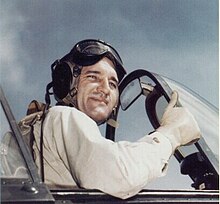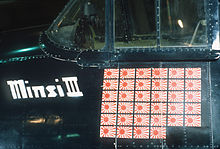

David McCampbell
| |
|---|---|

David McCampbell in the cockpit, c. 1943
| |
| Born | (1910-01-16)January 16, 1910 Bessemer, Alabama, US |
| Died | June 30, 1996(1996-06-30) (aged 86) Riviera Beach, Florida, US |
| Buried | |
| Allegiance | United States |
| Service/ | United States Navy |
| Years of service | 1933–1964 |
| Rank | Captain |
| Commands held | USS Bon Homme Richard USS Severn Carrier Air Group 15 VF-15 |
| Battles/wars | World War II |
| Awards | Medal of Honor Navy Cross Silver Star Legion of Merit with "V" device Distinguished Flying Cross (3) Air Medal (2) |
Captain David McCampbell (January 16, 1910 – June 30, 1996) was a United States Navy captain, naval aviator, and a Medal of Honor recipient. He retired from the navy in 1964 with 31 years of service.
McCampbell is the United States Navy's all-time leading flying ace (called Ace of the Aces in the Navy) and top F6F Hellcat ace with 34 aerial victories. He was the third-highest American scoring ace of World War II and the highest-scoring American ace to survive the war. He also set a United States single mission aerial combat record of shooting down nine enemy planes in one mission, on October 24, 1944, at the beginning of the Battle of Leyte Gulf, in the Philippines.

McCampbell was born in Bessemer, Alabama, and raised in West Palm Beach, Florida. He attended the Staunton Military Academy, in Virginia, and one year at the Georgia School of Technology, in Atlanta, before his appointment to the United States Naval Academy in 1929, where he graduated with the class of 1933 with a degree in marine engineering.
McCampbell's naval career actually began with a dismissal. Graduating from the U.S. Naval Academyindepression-era 1933, he was rewarded with an honorable discharge from a Navy without funds. But on June 1, 1934, McCampbell was called back and commissioned as an ensign in the U.S. Naval Reserve. He went on active duty on June 14, 1934, and served aboard the heavy cruiser USS Portland from June 1934 to June 1937 before he started flight training at Naval Air Station Pensacola, Florida.[1] He received his "wings of gold" as a Naval Aviator on April 21, 1938 and was assigned to Fighter Squadron Four (VF-4) on the aircraft carrier USS Ranger in May 1940.
McCampbell served as a landing signal officer (LSO) from May 1940, surviving the sinking of the carrier USS Wasp (CV-7) by a Japanese submarine near Guadalcanal on September 15, 1942.[2] He returned to the United States, was promoted to Lieutenant Commander, and was stationed at Naval Air Station Melbourne, Florida as LSO Instructor until August 1943.

McCampbell formed Fighter Squadron 15 (VF-15) on September 1, 1943 and led the squadron before being reassigned as Commander of Air Group 15 (CAG-15) in February 1944 to September 1944. As Commander, Carrier Air Group (CAG) 15, he was Commander of the Air Group (fighters, bombers, and torpedo bombers) when the group was embarked on the aircraft carrier USS Essex. From April to November 1944, his group saw six months of combat and participated in two major air-sea battles, the First and Second Battles of the Philippine Sea. During the more than 20,000 hours of air combat operations before it returned to the United States for a rest period, Air Group 15 destroyed more enemy planes (315 airborne and 348 on the ground) and sank more enemy shipping than any other Air Group in the Pacific War. Air Group 15's attacks on the Japanese in the Marianas and at Iwo Jima, Taiwan, and Okinawa were key to the success of the "island hopping" campaign.

In addition to his duties as commander of the "Fabled Fifteen", then Commander McCampbell became the Navy's "ace of aces" during the missions he flew in 1944. McCampbell entered combat on May 14[1] and flew at least four Grumman F6F Hellcats while aboard the Essex: an F6F-3 named Monsoon Maiden (damaged by AA, removed from service on 20 May 1944), an F6F-3 named The Minsi (10+1⁄2 kills), an F6F-5 named Minsi II, and an F6F-5 named Minsi III (Bureau Number 70143), in which he scored the last 23+1⁄2 of his 34 kills.
On June 19, 1944, during the "Marianas Turkey Shoot," Commander McCampbell shot down five Japanese Yokosuka D4Y 'Judy' dive-bombers, to become an "ace in a day". Later that afternoon, during a second sortie, McCampbell downed two Mitsubishi A6M 'Zekes' over Guam.
On October 24, 1944, in the initial phase of the Battle of Leyte Gulf, in the Philippines, he became the only American airman to achieve "ace in a day" status twice. McCampbell and his wingman attacked a Japanese force of 60 aircraft. McCampbell shot down nine—seven Zeros and two Oscars—setting a U.S. single-mission aerial combat record. During this same action, his wingman downed another six Japanese warplanes. When he landed his Grumman F6F Hellcat aboard USS Langley (the flight deck of Essex wasn't clear), his six machine guns had just two rounds remaining, and his airplane had to be manually released from the arrestor wire due to complete fuel exhaustion.[3] Commander McCampbell received the Medal of Honor for both actions, becoming the only Fast Carrier Task Force aviator to be so honored.
| Date | Total | Aircraft Types Claimed (location) |
|---|---|---|
| 11 Jun 1944 | 1 | Mitsubishi A6M Zeke destroyed (Saipan, Mariana Islands) |
| 13 Jun 1944 | 1 | Nakajima Ki-49 Helen destroyed (Saipan, Mariana Islands) |
| 19 Jun 1944 | 5 | Yokosuka D4Y Judys destroyed (1st sortie, Marianas Turkey Shoot, Philippine Sea) |
| 19 Jun 1944 | 2 | Mitsubishi A6M Zekes destroyed (2nd sortie, Guam, Mariana Islands) |
| 23 Jun 1944 | 11⁄2 | Mitsubishi A6M Zekes destroyed (1 shared credit with Ensign Claude Plant) (Orote Airfield, Guam, Mariana Islands) |
| 12 Sep 1944 | 4 | 2 x Mitsubishi A6M Zekes, 1 x Mitsubishi J2M Jack, 1 x Mitsubishi Ki-46 Dinah destroyed (Cebu Airfield, Philippines) |
| 13 Sep 1944 | 3 | 1Yokosuka K5Y Willow, 1 Nakajima Ki-43 Oscar &1B5N Kate destroyed (Negros Island, Philippines) |
| 22 Sep 1944 | 1 | Mitsubishi G3M Nell destroyed (Manila Bay, Philippines) |
| 23 Sep 1944 | 1⁄2 | Mitsubishi F1M2 Pete destroyed (credit shared with Ensign R. Nall) (Cebu Island, Philippines) |
| 21 Oct 1944 | 2 | 1Mitsubishi Ki-46 Dinah, 1 K5Y Willow destroyed (Tablas Island, Philippines) |
| 24 Oct 1944 | 9 | 5 x Mitsubishi A6M Zekes, 2 x Mitsubishi A6M3 Hamps & 2 x Nakajima Ki-43 Oscars destroyed (Leyte Gulf, Philippines) |
| 05 Nov 1944 | 2 | 1Aichi D3A Val &1Mitsubishi A6M Zeke destroyed (Nichols Field, Philippines) |
| 11 Nov 1944 | 1 | Nakajima Ki-43 Oscar destroyed (Ormoc Bay, Philippines) |
| 14 Nov 1944 | 1 | Nakajima Ki-43 Oscar destroyed (Manila Bay, Philippines) |
| 34 |
Following World War II, McCampbell had several postings. He returned to the United States in March 1945 and served as Chief of Staff to the Commander Fleet Air at NAS Norfolk, Virginia, until January 1947. He then attended Armed Forces Staff College in Norfolk, and remained as an instructor after graduating.
He served as the Senior Naval Aviation Advisor to the Argentine Navy, stationed at Buenos Aires, Argentina, from 1948 to January 1951, and then served as executive officer aboard USS Franklin D. Roosevelt during the Korean War (although the ship did not participate in combat) from February 1951 to March 1952. He was promoted to captain in July 1952;[4] he was assigned as the Planning Officer on the Staff of Commander Aircraft Atlantic from March 1952 to July 1953. He served as the Commanding Officer, Naval Air Technical Training Center Jacksonville at NAS Jacksonville, Florida, from July 1953 to July 1954. He then commanded the fleet oiler USS Severn, followed by the aircraft carrier USS Bon Homme Richard.
McCampbell was then assigned to the Joint Chiefs of Staff at the Pentagon from 1960 to September 1962. His final assignment was as Assistant Deputy Chief of Staff for Operations to the Commander in Chief, Continental Air Defense Command, where he served from September 1962 until his retirement from the navy on July 1, 1964.
McCampbell retired from active duty in 1964. He died in Florida in 1996 and was interred at Arlington National Cemetery.

McCampbell's decorations and awards include:[5]

| ||
|
|
||
|
|
||
|
|
||
| Naval Aviator Badge | ||
| Medal of Honor | Navy Cross | Silver Star |
| Legion of Merit w/ "V" device |
Distinguished Flying Cross w/ two 5⁄16" Gold Stars |
Air Medal w/ one 5⁄16" Gold Star |
| Joint Service Commendation Medal | Navy Presidential Unit Citation w/ one 3⁄16" bronze star |
Navy Distinguished Public Service Award |
| American Defense Service Medal w/ bronze "A" Device |
American Campaign Medal | European-African-Middle Eastern Campaign Medal w/ one 3⁄16" bronze star |
| Asiatic-Pacific Campaign Medal w/ one 3⁄16" silver star and two 3⁄16" bronze stars |
World War II Victory Medal | Navy Occupation Service Medal w/ 'Japan' clasp |
| National Defense Service Medal w/ one 3⁄16" bronze star |
Philippine Liberation Medal w/ two 3⁄16" bronze stars |
United States Navy Rifle Marksmanship Medal w/ Expert device |
Rank and Organization: Commander, United States Navy, Air Group 15
Place and Date: First and second battles of the Philippine Sea, 19 June 1944
Entered Service at: Florida
Born: January 16, 1910, Bessemer, Alabama
The President of the United States take pleasure in presenting the Medal of Honor to Commander David McCampbell, United States Navy for service as set forth in the following
Citation:
For conspicuous gallantry and intrepidity at the risk of his life above and beyond the call of duty as commander, Air Group Fifteen, during combat against enemy Japanese aerial forces in the First and Second Battles of the Philippine Sea. An inspiring leader, fighting boldly in the face of terrific odds, Commander McCampbell led his fighter planes against a force of eighty Japanese carrier-based aircraft bearing down on our Fleet on June 19, 1944. Striking fiercely in valiant defense of our surface force, he personally destroyed seven hostile planes during this single engagement in which the outnumbering attack force was utterly routed and virtually annihilated. During a major Fleet engagement with the enemy on October 24, Commander McCampbell, assisted by but one plane, intercepted and daringly attacked a formation of sixty hostile land-based craft approaching our forces. Fighting desperately but with superb skill against such overwhelming airpower, he shot down nine Japanese planes and, completely disorganizing the enemy group, forced the remainder to abandon the attack before a single aircraft could reach the Fleet. His great personal valor and indomitable spirit of aggression under extremely perilous combat conditions reflect the highest credit upon Commander McCampbell and the United States Naval Service.[citation needed]


| International |
|
|---|---|
| National |
|